Preservative Effects of Vacuum Packaging Combined with Cold Storage on Fresh-cut Taro
-
摘要: 鲜切芋头即使贮藏在低温条件下,切面也会出现变黄变褐的症状,导致商品性降低。为明确真空包装结合低温贮藏对鲜切芋头的保鲜效果,研究了低温贮藏条件下真空包装处理对鲜切芋头褐变和微生物总数的影响。结果表明:在低温贮藏条件下真空包装(VP)处理抑制了切面L*的下降,抑制a*、b*、色差(△E)和褐变指数(BI)的增加,表明VP处理能显著抑制鲜切芋头褐变。VP处理有效控制微生物的生长和繁殖,在12 d时细菌总数降低了94.31%,酵母总数降低了65.02%,表明VP结合低温贮藏对鲜切芋头具有很好的保鲜效果。VP处理降低了鲜切芋头PAL和PPO活性,降低了总酚、总黄酮和总可溶性醌含量,表明VP通过减少酚类物质的合成和氧化抑制鲜切芋头褐变。VP处理抑制CAT活性的下降,提高贮藏前期的POD活性,降低LOX活性、H2O2和MDA含量,表明VP处理通过保持鲜切芋头的抗氧化活性,延缓低温贮藏期间的品质劣变。本研究证实真空包装结合低温贮藏是一种保鲜效果好、简单易用的物理保鲜技术,为真空包装在鲜切芋头保鲜中的应用奠定了基础。Abstract: The cut surface of fresh-cut taro tends to yellowing and browning even stored at low temperatures, leading to a decrease in commercial values. In this study, to confirm the preservative effects of vacuum packaging (VP) combined with cold storage on fresh-cut taro, the effects of VP treatment on the browning and total microbial counts in fresh-cut taro during cold storage were studied. The results showed that VP treatment delayed the decrease of L* values and the increase of a*, b*, color differences (△E), and browning index (BI) values, indicating that VP treatment significantly prevented the browning of fresh-cut taro during cold storage. Furthermore, VP treatment effectively restrained the growth and reproduction of microbials, reducing the total number of bacteria by 94.31% and the total number of yeast by 65.02% at 12 d, suggesting that VP combined with cold storage had a good preservative effect on fresh-cut taro. VP treatment led to decreased PAL and PPO activities, as well as reduced levels of total phenolics, total flavonoids, and total soluble quinones, suggesting that VP treatment hindered the browning by reducing the biosynthesis and oxidation of phenolic compounds of fresh-cut taro. Moreover, VP treatment restrained the decline in CAT activity, increased POD activity at early storage, and reduced LOX activity, H2O2 contents and MDA contents, suggesting that VP treatment alleviated cutting-induced oxidative damages by maintaining the antioxidant activity of fresh-cut taro, thus restraining the quality deterioration during cold storage. This study demonstrates that VP treatment combined with cold storage is a physical preservative technology with good preservation effects, simple and easy to use, laying a foundation for the application of VP method in the preservation of fresh-cut taro.
-
Keywords:
- fresh-cut taro /
- vacuum package /
- cold storage /
- browning /
- pathogenic microbes
-
芋头(Colocasia esculenta)原产于中国、印度和马来半岛等国家或地区,地下肉质球茎是芋头的主要食用器官[1−2]。据联合国粮食与农业组织(FAO)统计,2019年芋头在中国的种植面积约为9.85万公顷,产量高达195.48万吨[3],说明芋头是我国重要的特色蔬菜。芋头的营养价值很高,兼具食用和药用价值[4−5]。但芋头在去皮过程中会造成皮肤瘙痒、红肿等过敏症状,给消费者的食用带来很大不便[6],限制了芋头的扩大消费。鲜切芋头在食用时无需再次加工,具有方便快捷的特点,更受消费者的青睐[7]。但芋头鲜切加工后因失去了天然的保护屏障(外表皮),切面很容易出现变黄、变褐的症状[8],环境中的病原微生物也更容易附着在表面生长繁殖,导致鲜切芋头的货架期很短。因此,研发能有效控制鲜切芋头品质劣变的采后处理技术,对于减少鲜切芋头的采后损失具有重要意义。
切面褐变是影响鲜切芋头外观品质的主要问题之一。已报道的可控制鲜切芋头褐变的方法主要可分为物理保鲜法和保鲜剂(褐变抑制剂)处理法两类。褐变抑制剂主要有:1-甲基环丙烯、N-乙酰-L-半胱氨酸、L-半胱氨酸、抗坏血酸、氯化钙、阿魏酸、肉桂酸、冰乙酸和乙醇等[9−14]。尽管褐变抑制剂处理能有效抑制鲜切芋头褐变,但保鲜效果与处理浓度有关。而高剂量的褐变抑制剂处理可能存在食品安全风险,高剂量保鲜剂的使用可能会增加消费者对食品安全的顾虑。物理法是安全性最高的保鲜方法之一,主要有壳聚糖涂膜处理[10,15]、γ射线照射处理[13]、不同材质的包装处理[16]、充氮包装[12]、热烫处理结合低温贮藏[17]等方法。外源施用一些植物生长发育调节剂,比如水杨酸、茉莉酸及其甲酯,也能在一定程度上抑制鲜切果蔬褐变[18−19],但植物生长发育调节剂的价格通常很高,在鲜切果蔬上应用不具有成本优势。
真空包装通过降低包装袋中的压力,减少包装中的氧气含量,从而达到保持鲜切果蔬品质的目的[20]。一些研究表明,抽真空包装能有效延缓菠萝[20]、莲藕[21]、杏鲍菇[22]、紫甘薯[23]、马铃薯[24]、皇冠梨[25]等鲜切果蔬的褐变和品质劣变速率。真空包装使鲜切果蔬处于低氧状态,降低产品的氧化反应和自身的生理代谢活动,具有简单易用、包装成本低、安全性高等优点[26],易于推广应用。Chang等[17]研究了真空包装单独处理以及结合热处理对去皮芋头感官品质的影响,发现单独真空包装处理能保持去皮芋头的感官品质,热处理能增强真空包装处理的保鲜效果。切面微生物的生长繁殖也是导致鲜切果蔬感官品质下降的重要原因,但该研究未探讨真空包装处理对切面微生物的影响。此外,鲜切果蔬的褐变速率还与切分面积有关。与去皮芋头相比,鲜切芋头暴露在空气中的面积更大,褐变速率更快,真空包装处理对鲜切芋头保鲜是否有效仍值得进一步确认。
本研究采用抽真空的方法包装鲜切芋头,在4 ℃冷藏条件下研究了真空包装处理对鲜切芋头褐变和微生物的抑制作用,以明确真空包装处理对鲜切芋头的保鲜效果,为安全高效的鲜切芋头保鲜技术研发提供参考。
1. 材料与方法
1.1 材料与仪器
芋头 品种为槟榔芋,于商品成熟度时采收。此时,芋头球茎已充分膨大,养分充分积累,地上部开始枯萎。挑选大小基本一致(单球茎重约800~1000 g),无机械伤和病虫害症状的芋头为试验材料;RP30普通塑料保鲜袋 美国GLAD佳能公司;14916真空包装专用保鲜袋 得力集团有限公司;30%过氧化氢(H2O2)溶液、甲醇、盐酸、丙酮、邻苯二酚、乙酸钠、亚油酸钠、碳酸钠、四硼酸钠、亚硝酸钠、氯化铝(六水)、硫酸镁(无水)、磷酸二氢钾 阿拉丁生化科技有限公司;一次性无菌细菌培养皿(60 mm×15 mm,圆形)、胰蛋白胨、酵母浸膏、葡萄糖、琼脂、氯霉素、乙酸、硼酸、愈创木酚、福林酚、L-苯丙氨酸、丙二醛(MDA)含量检测试剂盒、H2O2含量检测试剂盒、20×磷酸缓冲溶液(PBS) 生工生物工程(上海)有限公司。
14885抽真空封口机 得力集团有限公司;CR-400色差仪 日本柯尼卡美能达公司;MIR-554-PC低温恒温培养箱 松下电器(中国)有限公司;Sorvall ST 16R低温冷冻高速离心机 热电实验设备有限公司奥斯特罗德分公司;T2602可见紫外分光光度计 上海佑科仪器仪表有限公司;PCDX-WJ-10全自动超纯水仪 成都品成科技有限公司;SW-CJ-2FD超净工作台 广州科凯机电科技有限公司。
1.2 实验方法
1.2.1 真空包装处理和鲜切芋头贮藏条件
用自来水冲洗干净芋头表面的泥土后去皮,用不锈钢刀具横切成约1 cm厚度的薄片。将切分好的芋头分成两组,一组(CK)用普通食品保鲜袋密封包装,另一组(VP)使用真空专用包装袋抽真空包装。每个处理设置3个重复,每重复含有10片芋头,各处理共30片芋头。包装好的鲜切芋头放置在4 ℃低温恒温培养箱中贮藏,相对湿度(RH)为90%~95%。4 ℃低温贮藏期间,每隔2 d测定一次色度值,并收集样品用于后续测试分析。
1.2.2 色度测定
使用色差仪测定鲜切芋头片的色度值(L*、a*、b*),在每片芋头的三个不同部位分别测定一组色度数据,以三组数据的平均值代表该片芋头的色度值。色差(△E)和褐变指数(browning index,BI)根据下述公式计算[27]:
ΔE=√(ΔL∗)2+(Δa∗)2+(Δb∗)2 x=(a∗+1.75L∗)/(5.645L∗+a∗−3.012b∗) BI=[100(x−0.31)]/0.17 1.2.3 微生物计数
按照食品微生物学检验国家标准GB 4789.2-2016测定鲜切芋头表面的细菌总数,按照GB 4789.15-2016测定霉菌和酵母菌总数。
1.2.4 总酚和总黄酮含量的测定
根据Wang等[28]的方法测定总酚含量。将1 g芋头样品在5 mL的HCl-甲醇(1%)中均质成匀浆,室温浸提3 h。于11000 r/min室温离心15 min,上清液用于测定总酚含量。在5 mL离心管中依次加入0.2 mL上清液,0.8 mL超纯水,1 mL福林酚,1 mL的1 mol/L Na2CO3。反应液充分混匀后25 ℃水浴30 min,测定反应液在765 nm处的吸光度值,结果以mg/kg FW表示[29]。
参考Alcarcel等[30]的方法提取鲜切芋头总黄酮含量。将1 g样品在10 mL乙酸与丙酮混合提取液(每100 mL含0.5%乙酸和70%丙酮)中均质成匀浆。于4 ℃、11000 r/min离心15 min,收集上清液。在5 mL离心管中依次加入1.5 mL上清液,1 mL蒸馏水,0.1 mL的10%(m/v)AlCl3·6H2O,0.1 mL的5%(m/v)NaNO2和0.3 mL的1 mol/L NaOH,混匀后测定反应液在510 nm波长处的吸光度。根据吸光度值计算总黄酮含量,结果以mg/kg鲜重(FW)表示[29]。
1.2.5 总可溶性醌含量测定
将5 g样品在10 mL的甲醇溶液中均质成匀浆液,于室温12000 r/min条件下离心20 min,收集上清液。测定上清液在437 nm波长处的吸光度值,即为总可溶性醌的含量[31]。
1.2.6 褐变和抗氧化相关酶活性测定
根据Xiao等[29]和Wang等[28]的方法测定PAL、PPO、POD、CAT和LOX活性,酶活性以U/kg FW表示。
苯丙氨酸解氨酶(phenylalanine ammonia lyase,PAL)粗酶液的制备与活性测定:1 g样品在5 mL预冷的硼酸缓冲液(0.1 mol/L,pH8.8)中均质成匀浆液。在4 ℃条件下,将匀浆液于11000 r/min离心15 min。在5 mL离心管中加入0.1 mL的酶提取液、2.4 mL 0.1 mol/L硼酸缓冲液(pH8.8)和0.5 mL 20 mmol/L L-苯丙氨酸溶液混匀,37 ℃保温反应1 h。反应结束后加入0.1 mL 6 mol/L盐酸终止反应。用可见紫外分光光度计测定反应液在290 nm波长下的吸光度值,根据吸光度值计算PAL活性。
用于测定多酚氧化酶(polyphenol oxidase,PPO)、过氧化氢酶(catalase,CAT)、过氧化物酶(peroxidase,POD)、脂氧合酶(lipoxygenase,LOX)活性的粗酶液制备:1 g芋头样品在5 mL 4 ℃预冷的1×PBS缓冲溶液中均质成匀浆液,于4 ℃、11000 r/min离心15 min。收集上清液用于相关酶活性的测定。
PPO活性测定:在比色皿中加入0.2 mL酶提取液、2.8 mL 0.1%邻苯二酚,混匀后立即测定反应液在398 nm波长下3 min内的吸光度变化。
CAT活性测定:在比色皿中加入0.2 mL酶提取液、2.8 mL 1% H2O2,立即测定反应液在240 nm波长下3 min内的吸光度变化。
POD活性测定:在比色皿中加入0.1 mL酶提取液、2.9 mL反应混合液(含终浓度为0.1 mol/L愈创木酚和0.8% H2O2),记录反应液在470 nm波长下3 min内的吸光度变化。
LOX活性测定:在比色皿中加入0.1 mL酶提取液、2.9 mL反应混合液(含终浓度为0.1 mol/L乙酸钠和2 mmol/L亚油酸钠),记录反应液在234 nm波长下3 min内的吸光度变化。
1.2.7 过氧化氢和丙二醛含量测定
使用生工生物工程(上海)有限公司生产的试剂盒测定鲜切芋头中的H2O2和MDA含量[32]。
1.3 数据处理
在Microsoft Excel 2016软件中汇总整理实验数据,并制作柱形图和折线图,使用SPSS软件分析处理组间的差异显著性(P<0.05),统计分析使用Duncan多重比较法,用不同小写字母表示数据间的差异显著性。
2. 结果与分析
2.1 真空包装结合低温贮藏对鲜切芋头外观品质的影响
2.1.1 低温贮藏条件下鲜切芋头外观变化
在低温贮藏期间,对照组(CK)的鲜切芋头切面黄化逐渐加重,在贮藏第6 d时CK组芋头片边缘处表现出了明显的黄褐色症状,此时已基本没有商品价值。在12 d的贮藏期间,真空包装(VP)处理组未表现出任何的褐变症状,外观仍十分明亮(图1),说明VP处理能有效保持低温贮藏条件下鲜切芋头的外观品质。CK组的货架期最长为6 d,而VP组的货架期最短也有12 d,说明VP处理至少能延长6 d的货架期,能有效缓解鲜切芋头在短时间内不能销售出去而造成的浪费,减少采后经济损失。
2.1.2 真空包装结合低温贮藏对鲜切芋头色泽的影响
L*代表亮度,在低温贮藏期间,CK组的L*值快速下降,从最初(0 d)的85.82下降至12 d时的79.94,下降了6.85%。而VP处理组的L*值在整个贮藏期间变化不大,始终保持在85.18以上(图2A)。经过12 d的贮藏,CK组的L*值显著降低(P<0.05),而VP处理组的L*值没有产生显著变化(P>0.05)。VP处理组的L*值在贮藏第6 d、9 d和12 d时显著高于CK组(P<0.05)。
在整个低温贮藏期间,鲜切芋头表面的a*、b*、△E和BI值均呈总体增加趋势,CK组显著增加。与CK相比,VP组的a*值增加幅度明显小于对照组,b*、△E和BI值均基本没有增加(图2B~E)。VP处理组的a*值在贮藏第6和12 d时显著低于CK组(P<0.05),b*值在贮藏第9 d和12 d时显著低于CK(P<0.05),△E值在贮藏第6、9和12 d时显著低于CK(P<0.05),BI值在9和12 d时显著低于CK(P<0.05)。在12 d时,VP组的a*值比CK低25.78%,b*值比CK低29.32%,△E值比CK低66.64%,BI值比CK低35.55%。这些结果说明VP处理抑制了L*值的下降和a*、b*、△E和BI值的增加,VP处理组在贮藏12 d时切面亮度仍很高。
2.2 真空包装结合低温贮藏对微生物总数的影响
微生物在鲜切果蔬表面繁殖也会影响外观品质,因此,检测了真空包装对微生物总数的影响。在0 d时,CK和VP处理组的细菌总数基本相同,但在12 d时VP处理组的细菌总数显著低于CK组(P<0.05),比CK组低94.31%(图3A),说明VP处理能有效抑制细菌的生长繁殖。CK和VP组中的霉菌数在0 d和12 d时的变化不大,且两个处理组间无明显差异(图3B)。说明霉菌性真菌不适宜寄生在芋头表面生长繁殖,进一步表明霉菌不是引起鲜切芋头腐烂变质的主要病原微生物。在0 d时,CK和VP处理组中的酵母菌总数无显著差异(P>0.05),但在12 d时VP处理组的酵母菌总数显著低于CK组(P<0.05),比CK组低65.02%(图3C)。VP处理组中的酵母菌总数在0 d和12 d时无显著差异(P>0.05),说明经过12 d的贮藏,VP处理完全抑制了酵母菌的生长繁殖。在CK组中,与细菌相比,霉菌和酵母的菌落数在低温贮藏12 d后增加的幅度不大,说明细菌性病原微生物是引起鲜切芋头腐败变质的主要病原菌。
2.3 真空包装结合低温贮藏对鲜切芋头总酚、总黄酮和总可溶性醌含量的影响
CK组中的总酚含量在鲜切后显著增加(P<0.05),随后保持在较高水平;VP处理组的总酚含量先降低,随后又增加至与CK接近的水平(图4A)。与CK组相比,VP处理组的总酚含量在贮藏第3 d和6 d时显著低于对照(P<0.05)。CK组的总黄酮含量在贮藏期间逐渐增加,而VP组的总黄酮含量在鲜切芋头低温贮藏期间变化不大,且VP组的总黄酮含量显著低于CK组(P<0.05)(图4B)。CK组的总可溶性醌含量从0.42增加到0.53,增加了26.19%,而VP处理组的总可溶性醌含量始终低于0.42,显著低于对照组(P<0.05)(图4C)。这些结果表明,在低温贮藏条件下VP处理降低了总酚、总黄酮和总可溶性醌含量。
2.4 真空包装结合低温贮藏对鲜切芋头PAL和PPO活性的影响
研究表明,鲜切果蔬褐变与酚类物质的合成和氧化有关,PAL是合成酚类物质的关键酶之一,PPO是催化酚氧化的重要氧化酶[8]。由于VP包装处理能有效抑制鲜切芋头褐变,为此分析了VP处理对PAL和PPO活性的影响。
PAL活性在低温贮藏期间总体呈下降趋势,尽管在9 d时有所升高(图5A)。在贮藏期间的3、9 和12 d,CK组的PAL活性显著高于VP处理组(P<0.05)。CK组的PPO活性在前6 d基本与0 d时相同,但在贮藏第6 d后急剧增加,而VP处理组的PPO活性在整个贮藏期间始终保持在与0 d接近的水平(图5B)。在贮藏第12 d时,VP组的PPO活性比CK组低73.23%,表明VP处理有效抑制了PPO活性的增加。这些结果表明VP处理可能通过抑制PAL和PPO活性的增加,减少了酚类物质的合成和氧化。
2.5 真空包装结合低温贮藏对鲜切芋头活性氧代谢的影响
鲜切处理不可避免地对芋头造成机械伤,诱导以H2O2为主的活性氧大量生成,对鲜切芋头引起氧化损伤。CAT和POD是清除H2O2的重要抗氧化酶[33]。CK组的CAT活性在低温贮藏期间显著下降(P<0.05),经过12 d的贮藏降低了65.17%。而VP处理组的CAT活性在低温贮藏期间虽有所降低,但始终维持在较高水平,且显著高于CK组(P<0.05)(图6A)。说明VP处理能延缓CAT活性的下降,使鲜切芋头在低温贮藏期间能保持较高的活性氧清除能力。
POD活性在低温贮藏期间的变化趋势较为复杂,这可能与POD具有多重功能有关。在CK中先显著增加,在第6 d时又降至比第0 d更低的水平,随后在第9 d时急剧增加至最高活性。在VP处理中,POD活性在前6 d增加至最高值,随后又迅速降至比0 d时更低的活性。与CK相比,VP处理组的POD活性在第3 d和6 d时显著高于对照(P<0.05),在第9 d和12 d显著低于对照(P<0.05)(图6B),表明POD复杂地参与鲜切芋头褐变调控。
在整个低温贮藏期间,CK和VP处理组的H2O2含量显著增加,但VP处理的增加速率明显低于CK,且VP处理组的H2O2含量显著低于CK(P<0.05)(图6C)。在贮藏第12 d时,VP处理组的H2O2含量比CK低27.32%。H2O2是植物细胞内最主要的活性氧种类,而VP处理降低了H2O2含量,表明VP处理降低了鲜切芋头的活性氧含量,这可能是因为VP处理能保持较高CAT和POD活性。高活性的CAT和POD能及时清除细胞内产生的H2O2,从而缓解H2O2引起的氧化损伤。
2.6 真空包装结合低温贮藏对鲜切芋头膜脂过氧化的影响
膜脂过氧化是引起鲜切果蔬品质劣变的重要原因,LOX是促进细胞膜脂过氧化的关键催化酶之一,MDA含量可反映膜脂过氧化程度[34]。CK组的LOX活性在鲜切后逐渐增加,说明鲜切处理诱导了LOX活性。但VP处理组的LOX活性在整个低温贮藏期间增加的不多,且显著低于CK组(P<0.05),在第12 d时VP处理组的LOX活性比CK组低55.07%,说明VP处理抑制了切分诱导的LOX活性增加(图7A)。CK和VP处理组的MDA含量在整个贮藏期间均逐渐增加,但VP处理组的MDA含量在第9 d和12 d时显著低于CK组(P<0.05)(图7B)。这些结果表明,VP处理通过抑制LOX活性缓解鲜切芋头在低温贮藏条件下的膜脂过氧化反应。
3. 讨论与结论
色泽和微生物是影响鲜切果蔬贮藏品质和安全性的重要因素,也是衡量采后处理技术保鲜效果的重要指标[35]。本研究中,VP处理结合低温贮藏显著抑制了L*的下降和a*、b*、△E和BI的增加,说明VP处理能有效抑制鲜切芋头黄化和褐变。VP处理还降低了细菌和酵母菌落总数,说明VP处理也能有效控制病原微生物的生长繁殖。这些结果与真空包装在鲜切莲藕[21]、杏鲍菇[22]、马铃薯[24]和皇冠梨[25]中的保鲜作用相似,证明真空包装结合低温贮藏是一种保鲜效果好、可行性高、简单实用的物理保鲜技术。
非生物胁迫可通过激活苯丙烷途径诱导植物产生许多次生代谢产物,比如酚类和黄酮类物质[36],提高自身对逆境胁迫的耐受性。鲜切处理对果蔬而言本质上也是一种物理性的非生物胁迫,诱导次生代谢产物的合成积累本质是一种自我防御机制。但黄酮等物质会在鲜切果蔬表面表现出黄褐色症状,降低鲜切果蔬的商品性[37]。许多研究表明,通过调控PAL和PPO活性可控制鲜切果蔬褐变[38]。本研究发现VP处理能有效抑制鲜切芋头PAL和PPO活性,降低总酚、总黄酮和总可溶性醌含量,表明VP处理控制鲜切芋头褐变与酚类物质的合成与氧化反应被抑制有关。氧含量也是影响酶促褐变反应速率的重要因素,VP处理减少了包装环境中的氧含量,可能也是减少鲜切芋头褐变的重要原因。另外,真空包装条件下鲜切芋头的无氧呼吸可能会加强,VP处理是否通过提高无氧呼吸作用影响鲜切芋头的营养品质,有待进一步研究。
活性氧含量增加也是造成鲜切果蔬品质下降的重要原因。鲜切果蔬中过量积累的活性氧会对组织造成氧化损伤,影响膜的完整性和流动性,导致细胞膜功能下降甚至丧失[8]。提高抗氧化酶活性的保鲜方法可显著保持鲜切果蔬感官品质,降低病原微生物总数[39]。本研究中VP处理抑制了CAT活性的降低,提高了前6 d时POD活性,抑制了切分诱导的LOX活性,降低了H2O2和MDA含量。表明VP处理通过提高抗氧化酶活性,抑制LOX活性增加,缓解活性氧引起的氧化损伤。除具有清除活性氧的功能外,POD还参与了酚类物质的氧化聚合反应[33]。本研究中POD活性在前6 d时在VP处理中高于CK组,在第9 d和12 d时又低于CK组,显示POD在鲜切芋头褐变过程中功能的复杂性。
综上所述,VP处理结合低温贮藏能有效抑制鲜切芋头褐变,降低病原微生物总数,保持鲜切芋头贮藏品质。VP处理通过抑制切分诱导的PAL和PPO活性,抑制了酚类物质的生物合成和氧化聚合。VP处理通过提高CAT和POD活性,降低LOX活性,提高了鲜切芋头的抗氧化活性。本研究证实真空包装处理结合低温贮藏是一种简单实用、安全高效的鲜切芋头保鲜技术,具有一定的应用前景。
-
-
[1] 戴修纯, 罗燕羽, 黄绍力, 等. 广东省芋头产业现状与发展对策[J]. 广东农业科学,2021,48(6):126−135. [DAI X C, LUO Y Y, HUANG S L, et al. Present situation and development countermeasures of taro industry in Guangdong province[J]. Guangdong Agricultural Sciences,2021,48(6):126−135.] DAI X C, LUO Y Y, HUANG S L, et al. Present situation and development countermeasures of taro industry in Guangdong province[J]. Guangdong Agricultural Sciences, 2021, 48(6): 126−135.
[2] 李庆典, 杨永平, 李颖, 等. 中国芋种质资源的遗传多样性及分类研究[J]. 湖南农业大学学报(自然科学版),2004,30(5):424−428. [LI Q D, YANG Y P, LI Y, et al. Studies on genetic diversity and taxology of taro in China[J]. Journal of Hunan Agricultural University (Natural Sciences),2004,30(5):424−428.] doi: 10.3321/j.issn:1007-1032.2004.05.007 LI Q D, YANG Y P, LI Y, et al. Studies on genetic diversity and taxology of taro in China[J]. Journal of Hunan Agricultural University (Natural Sciences), 2004, 30(5): 424−428. doi: 10.3321/j.issn:1007-1032.2004.05.007
[3] 常蕾, 汪翔. 世界芋头产业发展现状综述[J]. 现代农业科技,2019(2):57−59. [CHANG L, WANG X. Overview of development status of taro industry in the world[J]. Modern Agricultural Sciences and Technology,2019(2):57−59.] doi: 10.3969/j.issn.1007-5739.2019.02.036 CHANG L, WANG X. Overview of development status of taro industry in the world[J]. Modern Agricultural Sciences and Technology, 2019(2): 57−59. doi: 10.3969/j.issn.1007-5739.2019.02.036
[4] 崔晓颖, 彭新颜, 贺红军, 等. 芋头多酚氧化酶的分离纯化与酶学特性[J]. 食品科学,2021,42(12):107−115. [CUI X Y, PENG X Y, HE H J, et al. Separation, purification and enzymatic characterization of polyphenol oxidase from taro[J]. Food Science,2021,42(12):107−115.] doi: 10.7506/spkx1002-6630-20200928-340 CUI X Y, PENG X Y, HE H J, et al. Separation, purification and enzymatic characterization of polyphenol oxidase from taro[J]. Food Science, 2021, 42(12): 107−115. doi: 10.7506/spkx1002-6630-20200928-340
[5] 王斌, 方美珊, 何金明. 芋头冻藏保鲜研究[J]. 食品研究与开发,2020,41(24):112−118. [WANG B, FANG M S, HE J M. Study on freezing storage of taro[J]. Food Research and Development,2020,41(24):112−118.] doi: 10.12161/j.issn.1005-6521.2020.24.019 WANG B, FANG M S, HE J M. Study on freezing storage of taro[J]. Food Research and Development, 2020, 41(24): 112−118. doi: 10.12161/j.issn.1005-6521.2020.24.019
[6] 王斌, 黄嘉坪, 肖艳辉, 等. 芳香植物纯露处理对鲜切芋头保鲜效果的影响[J]. 保鲜与加工,2020,20(3):41−46. [WANG B, HUANG J P, XIAO Y H, et al. Effects of hydrosol extracted from aromatic plants on preservation of fresh-cut taro[J]. Storage and Process,2020,20(3):41−46.] doi: 10.3969/j.issn.1009-6221.2020.03.007 WANG B, HUANG J P, XIAO Y H, et al. Effects of hydrosol extracted from aromatic plants on preservation of fresh-cut taro[J]. Storage and Process, 2020, 20(3): 41−46. doi: 10.3969/j.issn.1009-6221.2020.03.007
[7] 王斌, 方美珊, 肖艳辉, 等. 热处理条件筛选及其提高鲜切芋头贮藏品质的生理机制[J]. 食品工业科技,2020,41(10):284−288. [WANG B, FANG M S, XIAO Y H, et al. Screening of heat treatment conditions and its physiological mechanism in enhancing storage quality of fresh-cut taro[J]. Science and Technology of Food Industry,2020,41(10):284−288.] WANG B, FANG M S, XIAO Y H, et al. Screening of heat treatment conditions and its physiological mechanism in enhancing storage quality of fresh-cut taro[J]. Science and Technology of Food Industry, 2020, 41(10): 284−288.
[8] XIAO Y H, XIE J, WU C S, et al. Effects of melatonin treatment on browning alleviation of fresh-cut foods[J]. Journal of Food Biochemistry,2021,45(9):e13798.
[9] 谭谊谈, 曾凯芳. 1-MCP处理对鲜切芋艿褐变的影响[J]. 食品科学,2014,35(2):305−309. [TAN Y T, ZENG K F. Effect of 1-MCP treatment on browning of fresh-cut taro[J]. Food Science,2014,35(2):305−309.] doi: 10.7506/spkx1002-6630-201402060 TAN Y T, ZENG K F. Effect of 1-MCP treatment on browning of fresh-cut taro[J]. Food Science, 2014, 35(2): 305−309. doi: 10.7506/spkx1002-6630-201402060
[10] 张海珍. 不同保鲜技术对靖江香沙芋采后保鲜效果及生理代谢影响[D]. 扬州:扬州大学, 2019. [ZHANG H Z. Effects of different preservation techniques on postharvest preservation and physiological metabolism of Jingjiang Xiangsha taro[D]. Yangzhou:Yangzhou University, 2019.] ZHANG H Z. Effects of different preservation techniques on postharvest preservation and physiological metabolism of Jingjiang Xiangsha taro[D]. Yangzhou: Yangzhou University, 2019.
[11] 谭谊谈, 曾凯芳. 抗坏血酸、半胱氨酸与氯化钙复合处理对鲜切芋艿褐变的影响[J]. 食品科学,2014,35(4):231−235. [TAN Y T, ZENG K F. Effects of combined treatment with ascorbic acid, cysteine and CaCl2 on browning of fresh-cut taro[J]. Food Science,2014,35(4):231−235.] doi: 10.7506/spkx1002-6630-201404047 TAN Y T, ZENG K F. Effects of combined treatment with ascorbic acid, cysteine and CaCl2 on browning of fresh-cut taro[J]. Food Science, 2014, 35(4): 231−235. doi: 10.7506/spkx1002-6630-201404047
[12] 陆胜民, 果雅凝. 抗褐变剂和充气包装对鲜切芋头保鲜效果的研究[J]. 中国食品学报,2007,7(2):92−97. [LU S M, GUO Y N. Studies on the browning inhibitors and modified almosphere packaging for the fresh-keeping effect of fresh-cut taro[J]. Journal of Chinese Institute of Food Science and Technology,2007,7(2):92−97.] doi: 10.3969/j.issn.1009-7848.2007.02.018 LU S M, GUO Y N. Studies on the browning inhibitors and modified almosphere packaging for the fresh-keeping effect of fresh-cut taro[J]. Journal of Chinese Institute of Food Science and Technology, 2007, 7(2): 92−97. doi: 10.3969/j.issn.1009-7848.2007.02.018
[13] 大东. 鲜切甘蔗和芋头抗褐变剂筛选及其抗褐变机理研究[D]. 武汉:华中农业大学, 2019. [DALDOUM M A H. Study on screening anti-browning agents and mechanism of inhibiting the browning on fresh-cut sugarcane and taro [D]. Wuhan:Huazhong Agricultural University, 2019.] DALDOUM M A H. Study on screening anti-browning agents and mechanism of inhibiting the browning on fresh-cut sugarcane and taro [D]. Wuhan: Huazhong Agricultural University, 2019.
[14] XIAO Y H, ZHANG J L, JIANG Y Y, et al. Cinnamic acid treatment reduces the surface browning of fresh-cut taro[J]. Scientia Horticulturae,2022,291:110613. doi: 10.1016/j.scienta.2021.110613
[15] 胡位荣, 刘顺枝, 黄惠娟, 等. 抗坏血酸与壳聚糖处理对鲜切香芋贮藏效果的研究[J]. 食品科学,2010,31(24):436−439. [HU W R, LIU S Z, HUANG H J, et al. Effects of ascorbic acid and chitosan treatments on physiological changes of fresh-cut taro during storage[J]. Food Science,2010,31(24):436−439.] HU W R, LIU S Z, HUANG H J, et al. Effects of ascorbic acid and chitosan treatments on physiological changes of fresh-cut taro during storage[J]. Food Science, 2010, 31(24): 436−439.
[16] 许晓春, 林朝朋, 朱定和. 不同包装处理对切分芋头货架期的影响[J]. 食品研究与开发,2008,29(1):137−140. [XU X C, LIN C P, ZHU D H. Effects of different package treatments on fresh-cut taros shelf life[J]. Food Research and Development,2008,29(1):137−140.] doi: 10.3969/j.issn.1005-6521.2008.01.044 XU X C, LIN C P, ZHU D H. Effects of different package treatments on fresh-cut taros shelf life[J]. Food Research and Development, 2008, 29(1): 137−140. doi: 10.3969/j.issn.1005-6521.2008.01.044
[17] CHANG M S, KIM G H. Combined effect of hot water dipping and vacuum packaging for maintaining the postharvest quality of peeled taro[J]. Horticulture Environment and Biotechnology,2015,56(5):662−668. doi: 10.1007/s13580-015-0018-0
[18] 王欢. 水杨酸及其甲酯在鲜切马铃薯保鲜中的应用与机制初探[D]. 呼和浩特:内蒙古农业大学, 2021. [WANG H. The application and mechanism of salicylic acid and its methyl. ester in fresh-cut potato preservation[D]. Hohhot:Inner Mongolia Agricultural University, 2021.] WANG H. The application and mechanism of salicylic acid and its methyl. ester in fresh-cut potato preservation[D]. Hohhot: Inner Mongolia Agricultural University, 2021.
[19] 季悦, 李静, 王雷, 等. 茉莉酸甲酯处理对鲜切菠萝品质及抗氧化活性的影响[J]. 食品科学,2018,39(1):258−263. [JI Y, LI J, WANG L, et al. Effect of methyl jasmonate treatment on quality and antioxidant activity of fresh-cut pineapples[J]. Food Science,2018,39(1):258−263.] doi: 10.7506/spkx1002-6630-201801039 JI Y, LI J, WANG L, et al. Effect of methyl jasmonate treatment on quality and antioxidant activity of fresh-cut pineapples[J]. Food Science, 2018, 39(1): 258−263. doi: 10.7506/spkx1002-6630-201801039
[20] 方宗壮, 段宙位, 窦志浩, 等. 真空包装结合低温处理对鲜切菠萝贮藏品质的影响[J]. 食品工业科技,2018,39(6):259−264. [FANG Z Z, DUAN Z W, DOU Z H, et al. Effects of different vacuum packaging treatment with low temperature on storage quality of fresh-cut pineapple[J]. Science and Technology of Food Industry,2018,39(6):259−264.] FANG Z Z, DUAN Z W, DOU Z H, et al. Effects of different vacuum packaging treatment with low temperature on storage quality of fresh-cut pineapple[J]. Science and Technology of Food Industry, 2018, 39(6): 259−264.
[21] 冯向阳, 谢君, 王宏勋, 等. 真空包装通过调节酶活性抑制鲜切莲藕酶促褐变[J]. 江苏农业科学,2019,47(7):210−214. [FENG X Y, XIE J, WANG H X, et al. Vacuum packaging inhibits enzymatic browning of fresh-cut lotus roots by regulating enzyme activity[J]. Jiangsu Agricultural Sciences,2019,47(7):210−214.] FENG X Y, XIE J, WANG H X, et al. Vacuum packaging inhibits enzymatic browning of fresh-cut lotus roots by regulating enzyme activity[J]. Jiangsu Agricultural Sciences, 2019, 47(7): 210−214.
[22] 邱爱东, 李翔, 刘海强, 等. 冷藏温度对真空包装杏鲍菇品质的影响[J]. 成都大学学报(自然科学版),2019,38(2):146−149. [QIU A D, LI X, LIU H Q, et al. Effects of refrigerated storage temperature on Pleurotus eryngii by vacuum packaging[J]. Journal of Chengdu University (Natural Science Edition),2019,38(2):146−149.] doi: 10.3969/j.issn.1004-5422.2019.02.007 QIU A D, LI X, LIU H Q, et al. Effects of refrigerated storage temperature on Pleurotus eryngii by vacuum packaging[J]. Journal of Chengdu University (Natural Science Edition), 2019, 38(2): 146−149. doi: 10.3969/j.issn.1004-5422.2019.02.007
[23] 于筠. 鲜切紫甘薯褐变控制技术的研究[D]. 天津:天津科技大学, 2019. [YU J. Study on control technology of fresh-cut purple sweet potato browning[D]. Tianjin:Tianjin University of Science and Technology, 2019.] YU J. Study on control technology of fresh-cut purple sweet potato browning[D]. Tianjin: Tianjin University of Science and Technology, 2019.
[24] 公营, 王庆国, 孟庆昌, 等. 鲜切马铃薯褐变控制技术研究进展[J]. 食品安全质量检测学报,2019,10(19):6573−6578. [GONG Y, WANG Q G, MENG Q C, et al. Advances on the inhibition techniques of browning of fresh-cut potato[J]. Journal of Food Safety and Quality,2019,10(19):6573−6578.] GONG Y, WANG Q G, MENG Q C, et al. Advances on the inhibition techniques of browning of fresh-cut potato[J]. Journal of Food Safety and Quality, 2019, 10(19): 6573−6578.
[25] 朱万慧, 王艳颖, 马堃, 等. 真空包装下不同温度对鲜切皇冠梨生理生化的影响[J]. 现代园艺,2018(10):11−14. [ZHU W H, WANG Y Y, MA K, et al. Effects of different temperatures on physiology and biochemistry of fresh-cut crown pears under vacuum packaging[J]. Modern Horticulture,2018(10):11−14.] doi: 10.3969/j.issn.1006-4958.2018.19.006 ZHU W H, WANG Y Y, MA K, et al. Effects of different temperatures on physiology and biochemistry of fresh-cut crown pears under vacuum packaging[J]. Modern Horticulture, 2018(10): 11−14. doi: 10.3969/j.issn.1006-4958.2018.19.006
[26] 徐冬颖, 周福慧, 蒋海峰, 等. 真空包装结合避光处理对鲜切马铃薯的品质影响[J]. 食品科学,2020,41(13):184−192. [XU D Y, ZHOU F H, JIANG H F, et al. Effect of vacuum combined with light-proof packaging on quality of fresh-cut potatoes[J]. Food Science,2020,41(13):184−192.] doi: 10.7506/spkx1002-6630-20190704-059 XU D Y, ZHOU F H, JIANG H F, et al. Effect of vacuum combined with light-proof packaging on quality of fresh-cut potatoes[J]. Food Science, 2020, 41(13): 184−192. doi: 10.7506/spkx1002-6630-20190704-059
[27] YUAN X, TANG B L, WANG Y K, et al. Inhibitory effects of peppermint extracts on the browning of cold-stored fresh-cut taro and the phenolic compounds in extracts[J]. Frontiers in Sustainable Food Systems,2023,7:1191396. doi: 10.3389/fsufs.2023.1191396
[28] WANG B, HUANG Y Y, ZHANG Z M, et al. Ferulic acid treatment maintains the quality of fresh-cut taro (Colocasia esculenta) during cold storage[J]. Frontiers in Nutrition,2022,9:884844. doi: 10.3389/fnut.2022.884844
[29] XIAO Y H, HE J M, ZENG J, et al. Application of citronella and rose hydrosols reduced enzymatic browning of fresh-cut taro[J]. Journal of Food Biochemistry,2020,44(8):e13283.
[30] ALCARCEL J, REILLY K, GAFFNEY M. Antioxidant activity, total phenolic and total flavonoid content in sixty varieties of potato (Solanum tuberosum L.) grown in Ireland[J]. Potato Research,2015,58(3):221−244. doi: 10.1007/s11540-015-9299-z
[31] ALI S, KHAN A S, MALIK A U, et al. Combined application of ascorbic and oxalic acids delays postharvest browning of litchi fruits under controlled atmosphere conditions[J]. Food Chemistry,2021,350:129277. doi: 10.1016/j.foodchem.2021.129277
[32] WANG B, WANG Y K, JIANG Y Y, et al. Anti-browning effects of citronellal on fresh-cut taro (Colocasia esculenta) slices under cold storage condition[J]. Frontiers in Sustainable Food Systems,2022,6:1001362. doi: 10.3389/fsufs.2022.1001362
[33] MITTLER R, ZANDALINAS S I, FICHMAN Y, et al. Reactive oxygen species signaling in plant stress responses[J]. Nature Reviews Molecular Cell Biology,2022,23(10):663−679. doi: 10.1038/s41580-022-00499-2
[34] LI Z H, ZHANG Y X, GE H B. The membrane may be an important factor in browning of fresh-cut pear[J]. Food Chemistry,2017,230:265−270. doi: 10.1016/j.foodchem.2017.03.044
[35] 袁瑞敏, 胡铭文, 闵婷, 等. 乙烯利通过调节酚类物质和活性氧代谢维持鲜切荸荠的贮藏品质[J]. 食品安全质量检测学报,2023,14(5):217−225. [YUAN R M, HU M W, MIN T, et al. Ethephon maintains the storage quality of fresh-cut Eleocharis tub erosa by regulating phenolic and reactive oxygen species metabolism[J]. Journal of Food Safety and Quality,2023,14(5):217−225.] doi: 10.3969/j.issn.2095-0381.2023.5.spaqzljcjs202305028 YUAN R M, HU M W, MIN T, et al. Ethephon maintains the storage quality of fresh-cut Eleocharis tuberosa by regulating phenolic and reactive oxygen species metabolism[J]. Journal of Food Safety and Quality, 2023, 14(5): 217−225. doi: 10.3969/j.issn.2095-0381.2023.5.spaqzljcjs202305028
[36] 黄泳谚, 易景怡, 王斌. 采后黄瓜响应低温胁迫的转录组学分析[J]. 热带作物学报,2023,44(1):35−48. [HUANG Y Y, YI J Y, WANG B. Transcriptomic analysis of harvested cucumber in response to cold stress[J]. Chinese Journal of Tropical Crops,2023,44(1):35−48.] doi: 10.3969/j.issn.1000-2561.2023.01.005 HUANG Y Y, YI J Y, WANG B. Transcriptomic analysis of harvested cucumber in response to cold stress[J]. Chinese Journal of Tropical Crops, 2023, 44(1): 35−48. doi: 10.3969/j.issn.1000-2561.2023.01.005
[37] SONG M B, WU S J, SHUAI L, et al. Effects of exogenous ascorbic acid and ferulic acid on the yellowing of fresh-cut Chinese water chestnut[J]. Postharvest Biology and Technology,2019,148:15−21. doi: 10.1016/j.postharvbio.2018.10.005
[38] QIAO L, HAN X, WANG H, et al. Novel alternative for controlling enzymatic browning:Catalase and its application in fresh-cut potatoes[J]. Journal of Food Science,2021,86(8):3529−3539. doi: 10.1111/1750-3841.15827
[39] LI C, WANG S, WANG J Y, et al. Ozone treatment promotes physicochemical properties and antioxidant capacity of fresh-cut red pitaya based on phenolic metabolism[J]. Frontiers in Nutrition,2022,9:1016607. doi: 10.3389/fnut.2022.1016607
-
期刊类型引用(1)
1. 樊爱萍,邓秋红,曾丽萍,杨光明,李毓冰,刘春艳. 超声波处理结合微孔气调包装对鲜切菠萝蜜冷藏品质的影响. 食品工业科技. 2025(04): 350-357 .  本站查看
本站查看
其他类型引用(0)






 下载:
下载:

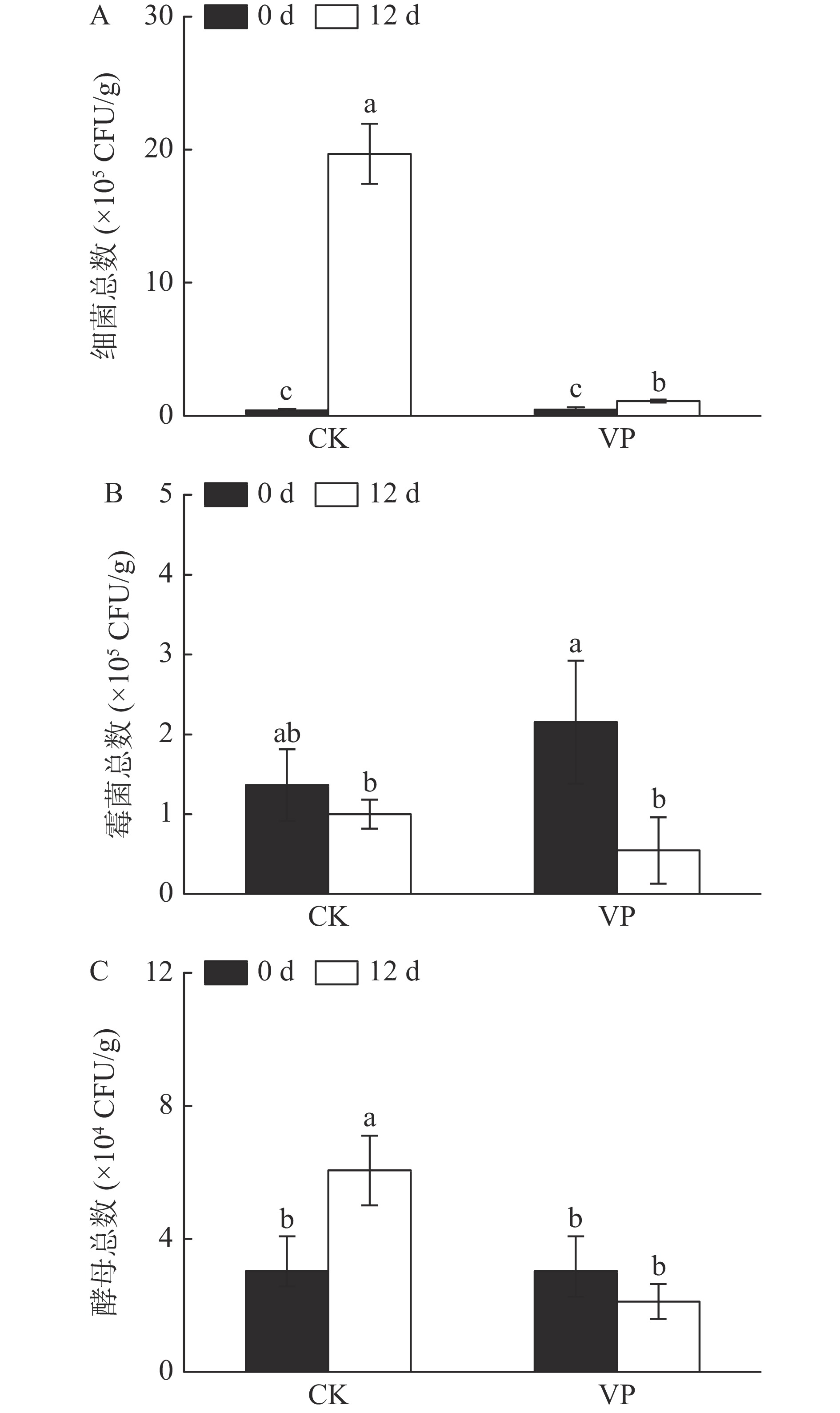
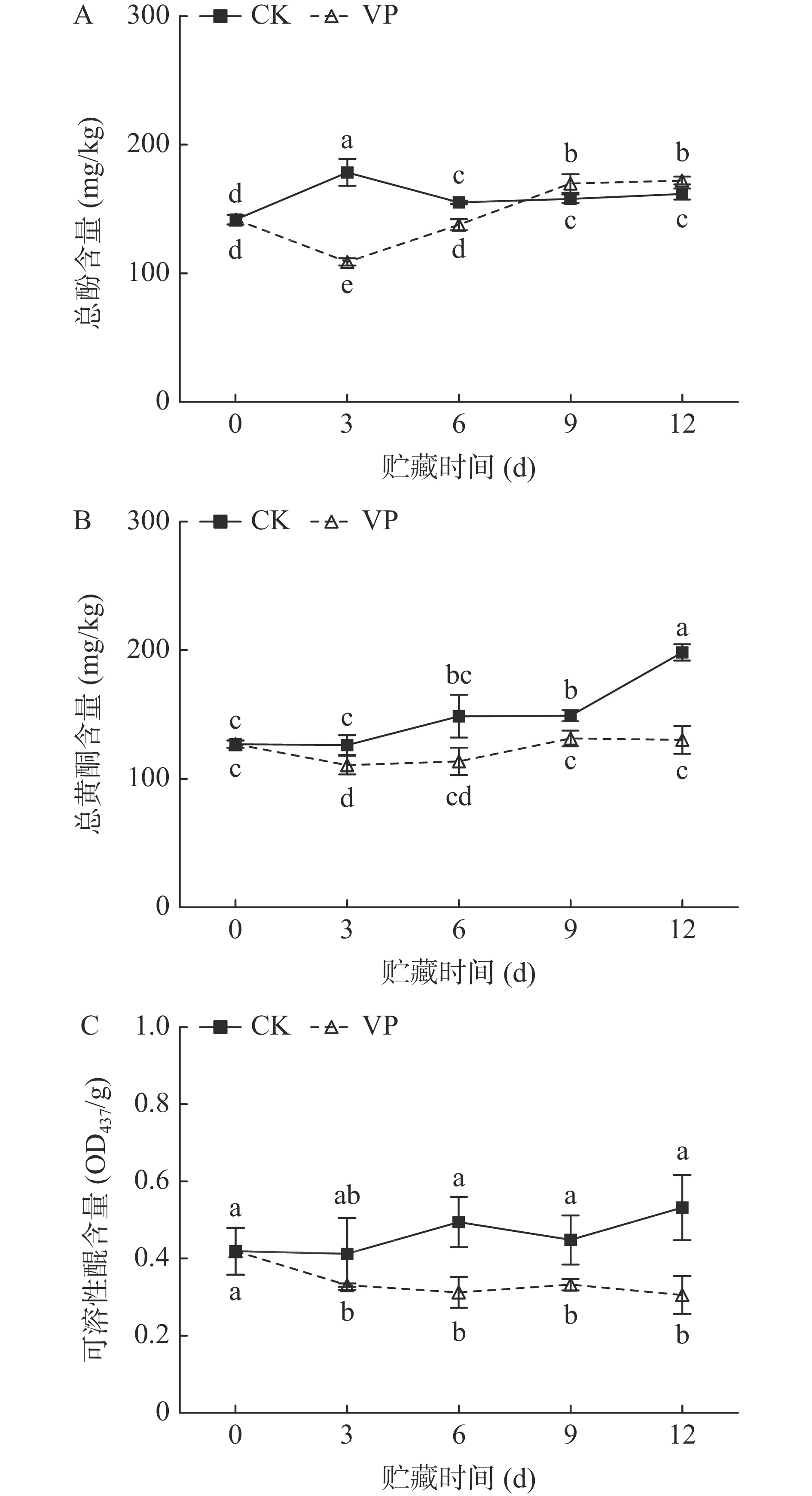
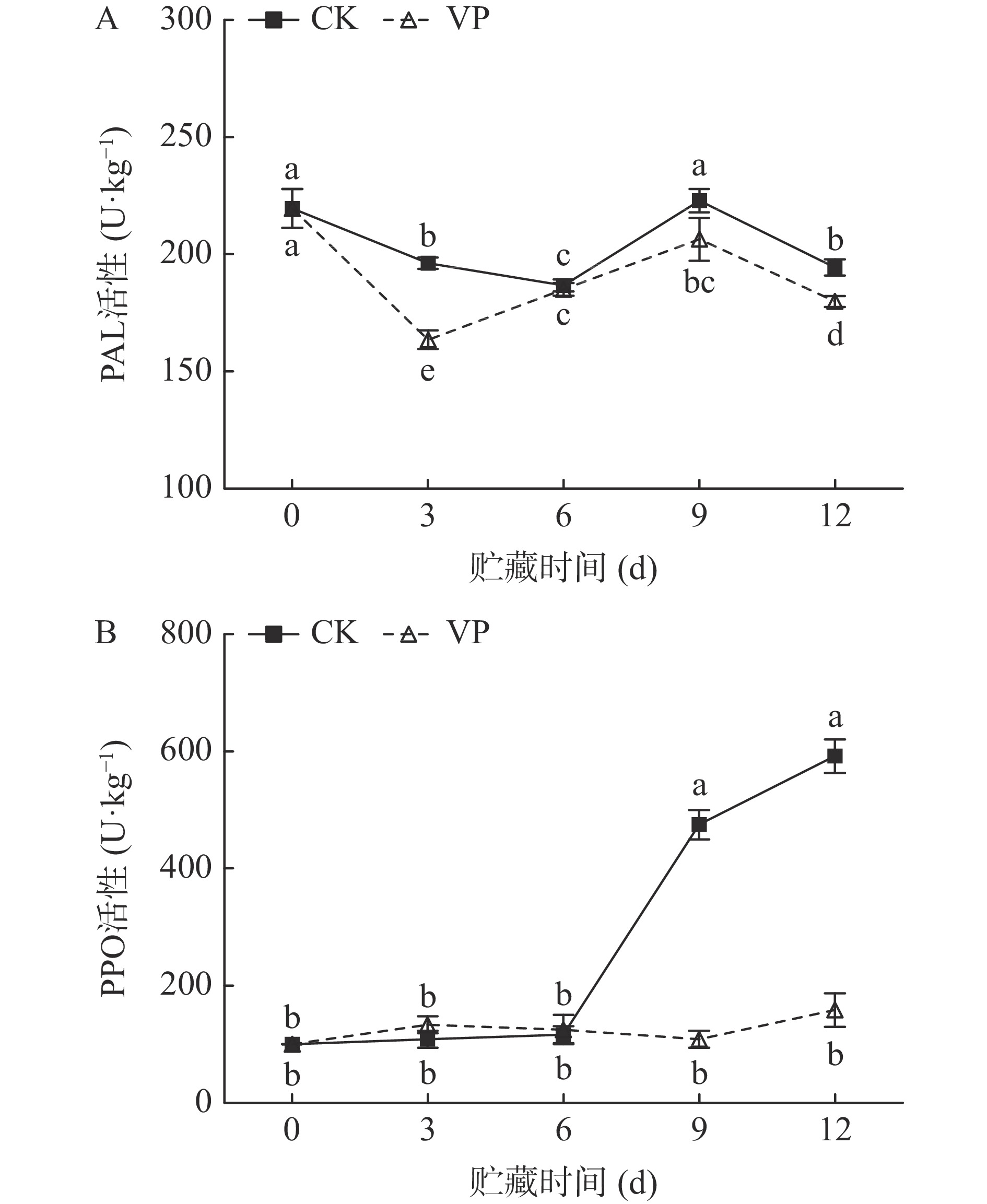
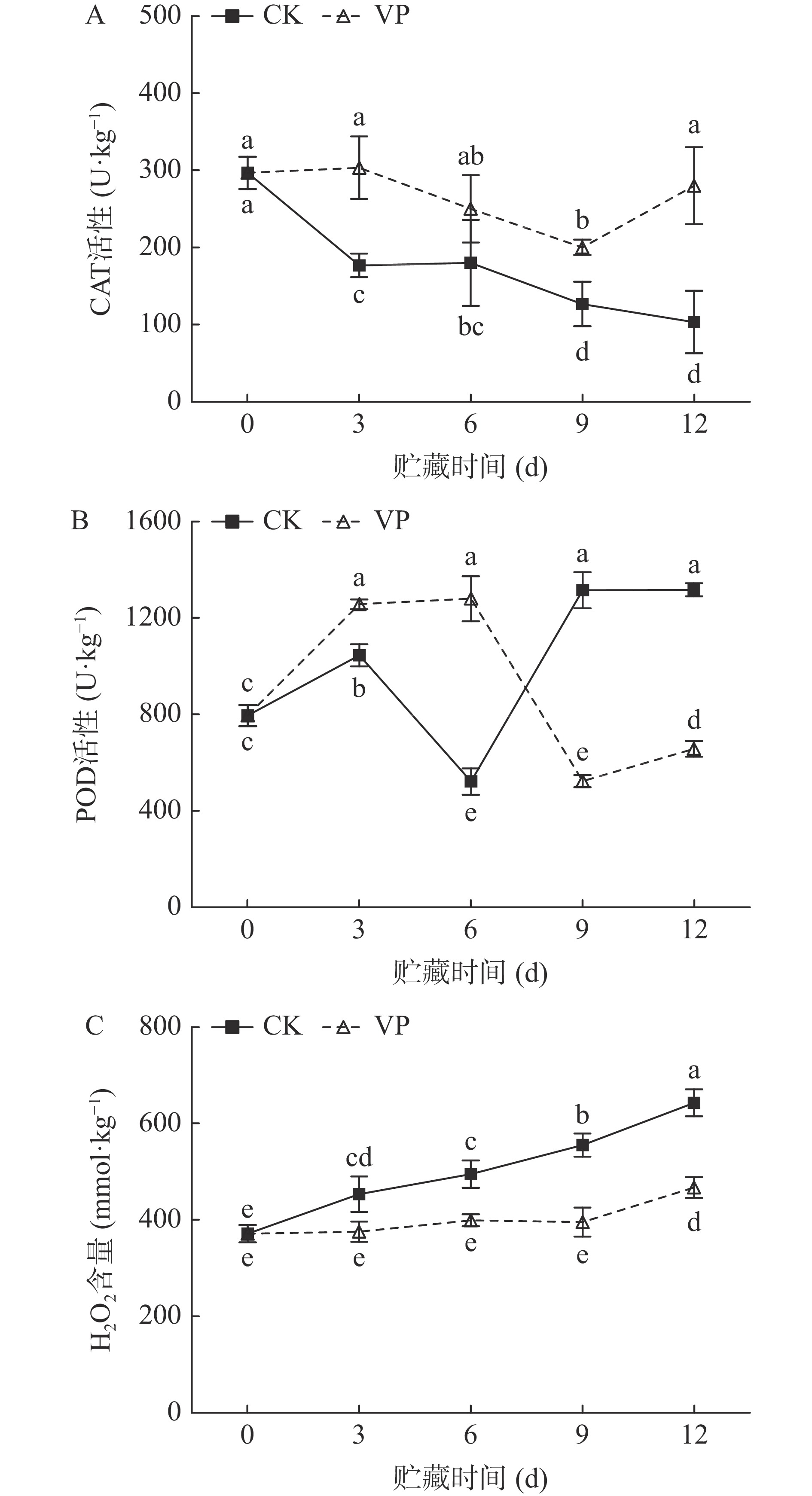
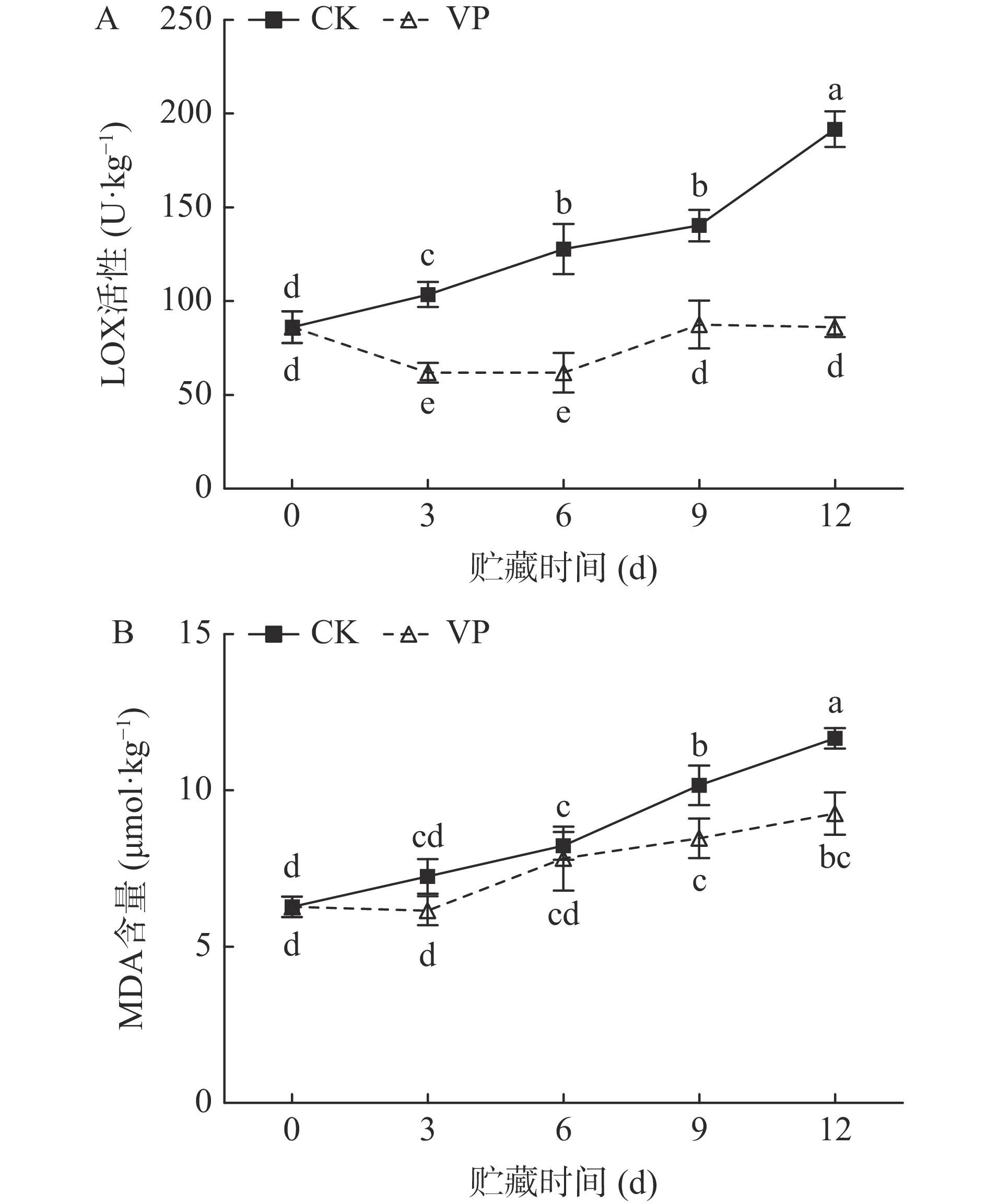
 下载:
下载:



